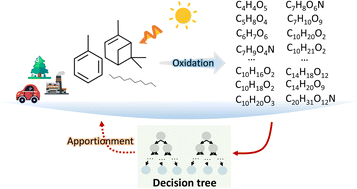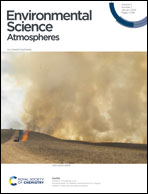Precursor apportionment of atmospheric oxygenated organic molecules using a machine learning method†
Abstract
Gas-phase oxygenated organic molecules (OOMs) can contribute significantly to both atmospheric new particle growth and secondary organic aerosol formation. Precursor apportionment of atmospheric OOMs connects them with volatile organic compounds (VOCs). Since atmospheric OOMs are often highly functionalized products of multistep reactions, it is challenging to reveal the complete mapping relationships between OOMs and their precursors. In this study, we demonstrate that the machine learning method is useful in attributing atmospheric OOMs to their precursors using several chemical indicators, such as O/C ratio and H/C ratio. The model is trained and tested using data acquired in controlled laboratory experiments, covering the oxidation products of four main types of VOCs (isoprene, monoterpenes, aliphatics, and aromatics). Then, the model is used for analyzing atmospheric OOMs measured in both urban Beijing and a boreal forest environment in southern Finland. The results suggest that atmospheric OOMs in these two environments can be reasonably assigned to their precursors. Beijing is an anthropogenic VOC dominated environment with ∼64% aromatic and aliphatic OOMs, and the other boreal forested area has ∼76% monoterpene OOMs. This pilot study shows that machine learning can be a promising tool in atmospheric chemistry for connecting the dots.

- This article is part of the themed collection: The Use of Machine Learning in Atmospheric Science Research - Topic Highlight


 Please wait while we load your content...
Please wait while we load your content...